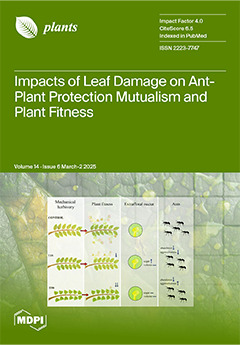Mechanical injury to lettuce often leads to enzymatic browning caused by polyphenol oxidase (PPO), significantly impairing its sensory quality and processing suitability. In this study, the
LsPPOs gene family was comprehensively identified and characterized using bioinformatics methods, including gene and protein structure, codon
[...] Read more.
Mechanical injury to lettuce often leads to enzymatic browning caused by polyphenol oxidase (PPO), significantly impairing its sensory quality and processing suitability. In this study, the
LsPPOs gene family was comprehensively identified and characterized using bioinformatics methods, including gene and protein structure, codon usage bias, phylogenetic relationships, and gene expression in response to wound stress. Further analysis of the relationship between
LsPPOs expression profile and browning was performed. A total of 17
LsPPO family members (
LsPPO1-LsPPO17) were identified from publicly available lettuce databases, encoding proteins ranging from 146 to 667 amino acids, with a G/C bias. Most were localized in the chloroplast. The motif structure was highly conserved among family members, and phylogenetic analysis revealed four distinct groups. All genes lacked introns, except
LsPPO2 which contained an intron. After mechanical injury, browning at the stem site deepened over time, with PPO activity increasing. The majority of
PPO members were significantly upregulated after fresh-cut processing. Among them,
LsPPO3,
LsPPO4, and
LsPPO12 showed sustained upregulation, exhibiting a strong positive correlation with the browning phenotype and PPO activity. Notably,
LsPPO4 demonstrated the highest transcriptional abundance and upregulation in response to a wound, indicating its major role in lettuce stem browning. The results of this study provide a foundation for further investigation into the functional role of
LsPPOs and support the development of lettuce varieties with enhanced resistance to browning.
Full article






